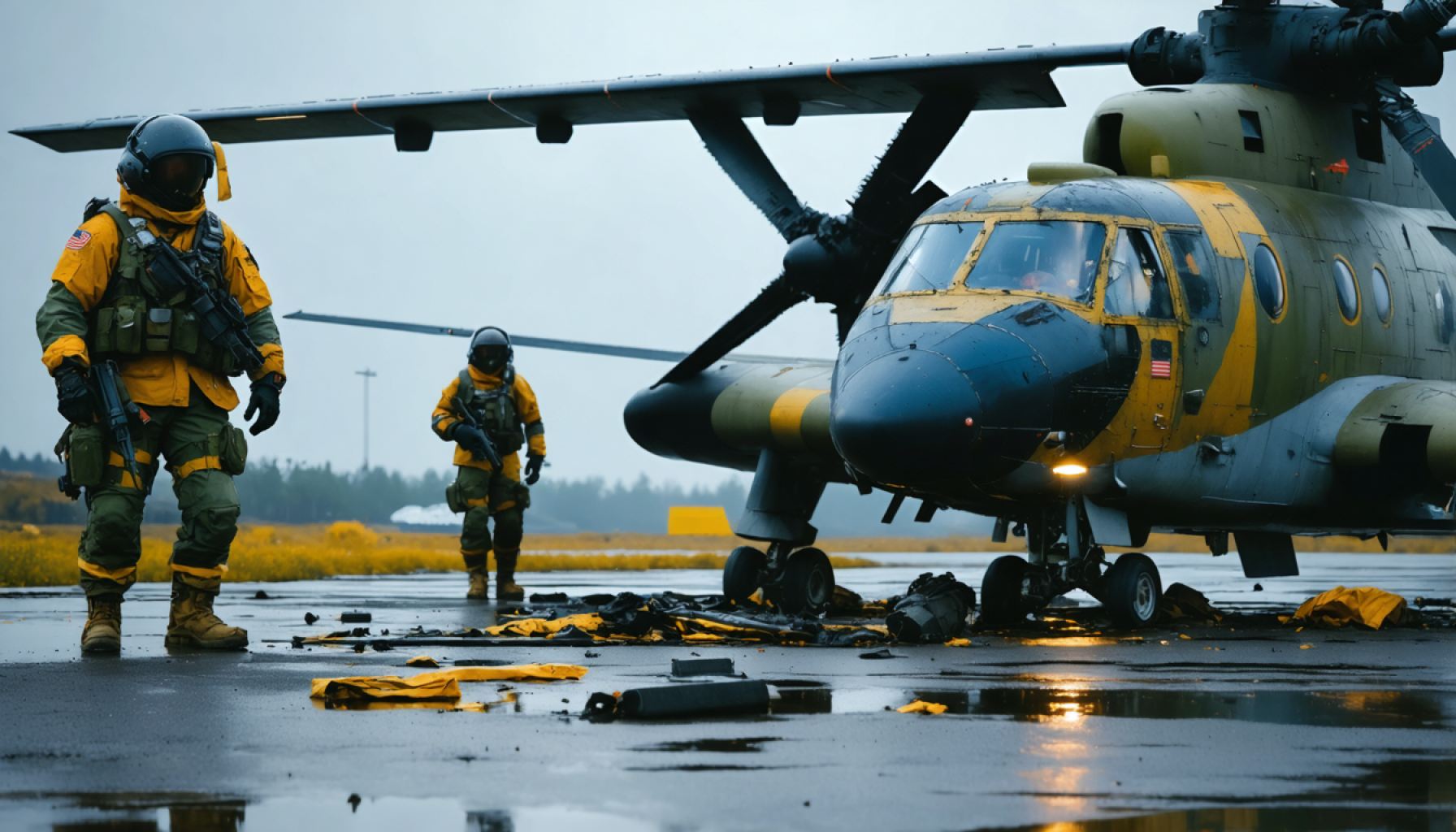- Colonel (res.) Yoav Yarom discusses the controversial mission involving the deaths of journalist Ze’ev Erlich and IDF soldier Gur Kehati, sparking national debate.
- Erlich’s participation in conflict zones was a known, strategic decision endorsed by senior IDF commanders, highlighting complexities in military operations.
- Yarom defends allowing Erlich into combat areas like Lebanon and the West Bank, equating their dangers and emphasizing operational transparency.
- The tragedy raises questions about the risks of civilian involvement in military endeavors and prompts calls for tighter regulatory measures.
- Yarom reflects on setting boundaries between bravery and vulnerability, underscoring the challenges of balancing transparency and safety.
- The article highlights the broader dialogue on military responsibility and the cost of journalistic bravery in conflict zones.
From the undulating hills of southern Lebanon to the bustling cities of the West Bank, the Israeli Defense Forces (IDF) have often found themselves navigating a labyrinth of decisions that test the boundaries of duty and discretion. A recent televised revelation has reopened one such chapter, sparking a fervent national debate.
Colonel (res.) Yoav Yarom, in a candid moment of reflection, shared insights during an investigative report on the ill-fated mission that led to the deaths of renowned civilian journalist Ze’ev ‘Jabo’ Hanoch Erlich and IDF combat soldier Gur Kehati. The interview, characterized by its raw introspection, unfolded on Channel 12’s “Uvda,” shedding light on the layers of complexity surrounding the decision to allow a civilian into the hazardous theater of Lebanon.
Yarom, standing firmly by his decisions, articulated the grave calculus that preceded Erlich’s inclusion in the mission. Known within the higher echelons of the IDF, Erlich was not just an outsider; his presence in combat zones had been a constant, tacitly endorsed by senior commanders. With each foray into conflict, whether under the ominous shadows of Lebanon or the perilous streets of the West Bank, Erlich’s engagement was more than just permitted—it was acknowledged as part of the operational strategy.
Yet, questions linger like smoke in the aftermath of a battlefield. Why risk civilian life in the throes of combat? Yarom contended with this notion, equating the perils of Lebanon with those faced in the West Bank, where the gritty reality is punctuated by danger at every corner. Nightly excursions into hotspots like the Kasbah in Nablus, he argued, were not void of mortal risk.
The circumstances of the tragedy fuel a discussion that binds journalistic bravery with military prudence. As Yarom articulated, Erlich’s role was neither clandestine nor erratic; it was a choreographed sequence of operations known to commanders, with movements sometimes outlined in modern-day digital dispatches like WhatsApp groups.
Yet, despite the openness in operations, Yarom acknowledges his own moments of doubt and restraint—times when the storm of war demanded isolation from civilian presence. The boundaries he occasionally set underscored his recognition of an ever-present line between valor and vulnerability.
In the wake of Erlich and Kehati’s untimely demise, Israel finds itself questioning the protocols that govern civilian participation in military endeavours. The legacy of Erlich, marked by his audacious pursuit of truth under fire, is juxtaposed with the demand for tighter regulatory oversight in conflict zones. As the IDF continues its introspection, a larger dialogue emerges about the cost of transparency and the scales of risk that commanders must balance, redefining the essence of responsibility amid the chaos of war.
This somber narrative serves as a stark reminder of the intricacies of military operations. The tales of courage that emerge are, at times, also narratives of caution—a testament to the human element within the orchestra of strategy and sacrifice.
Inside the Complex World of Military Journalism: Lessons from Lebanon’s Frontlines
Understanding the Broader Context: Military Operations and Civilian Involvement
The tragic loss of journalist Ze’ev ‘Jabo’ Hanoch Erlich and IDF soldier Gur Kehati in Lebanon brings into focus several critical aspects of military and journalistic operations that were only touched upon in the original discussion. This incident highlights the delicate balance between gaining firsthand insights into conflict zones and ensuring the safety of all involved parties. Let’s delve into some additional insights and considerations.
Why Allow Civilians into Combat Zones?
1. Firsthand Reporting:
– Journalists like Erlich are crucial for providing on-ground perspectives that can shape public opinion and policy. The real-time reports and stories bring the realities of conflict to those far removed from its immediate effects.
2. Operational Strategy Enhancement:
– Civilians embedded within military units can serve as liaisons, offering external viewpoints and aiding in strategic communication efforts. Their presence can help demystify complex operations to a broader audience.
Exploring Pressing Questions
Why was Erlich’s presence tacitly endorsed by the IDF?
Erlich’s embedded status was not an isolated decision; it was part of an operational strategy acknowledged by senior commanders. His insights and dedication to truth-telling were seen as valuable assets in conflict reporting. As an embedded journalist, he had the unique ability to amplify the IDF’s perspective, thus shaping the narrative of military engagements.
What protocols govern civilian involvement in these high-risk scenarios?
While military frameworks may permit civilian presence for strategic reasons, there is an ongoing debate about the ethical and safety protocols necessary to protect civilians and soldiers alike. The need for comprehensive risk assessments and clear guidelines for civilian participation is getting more attention following incidents like this.
Real-World Use Cases and Lessons
– How-To Steps for Journalistic Engagement in Conflict Zones:
1. Pre-Deployment Training: Journalists and civilians should undergo rigorous training on safety, communication protocols, and cultural sensitivity specific to the conflict area.
2. Collaborative Planning: Journalists should actively participate in mission briefs and debriefs to understand missions’ scope and danger.
3. Clear Communication Lines: Establish dedicated channels for instant communication during operations for quick updates and emergency assistance.
4. Exit Strategies: Develop pre-determined exit routes and plans to ensure rapid evacuation if the situation deteriorates.
– Life Hacks for Balancing Risk and Reporting:
– Use technology like GPS and satellite communication to maintain safe positioning and allow extraction teams to locate individuals accurately during emergencies.
– Develop a network of local contacts to gain insights and guidance on ground realities and cultural dynamics unseen by foreign journalists.
Market Forecast and Trends in Military Journalism
With technological advancements, the presence of civilians, particularly journalists in combat zones, might see increasing reliance on remote technologies. Drones and AI-powered reporting tools will likely play a larger role, minimizing risk while continuing to deliver powerful narratives from conflict zones.
Actionable Recommendations
1. Enhance Training Programs: Both journalists and military personnel should engage in joint training exercises to understand each other’s operational protocols and enhance mutual safety.
2. Implement Technological Solutions: Invest in tech solutions like VR for training and drones for reporting, reducing the physical presence of humans in active war zones.
3. Establish Clear Guidelines and Ethical Standards: Develop comprehensive protocols for embedding civilians in military units, ensuring adherence to ethical standards and prioritizing safety.
By incorporating these insights, military and journalistic fields can evolve to better manage the inherent risks associated with frontline reporting, ensuring that bravery in pursuit of the truth is matched by robust safety and ethical standards.
For further information on the Israeli Defense Forces and their operations, visit the official Israeli Defense Forces website.









